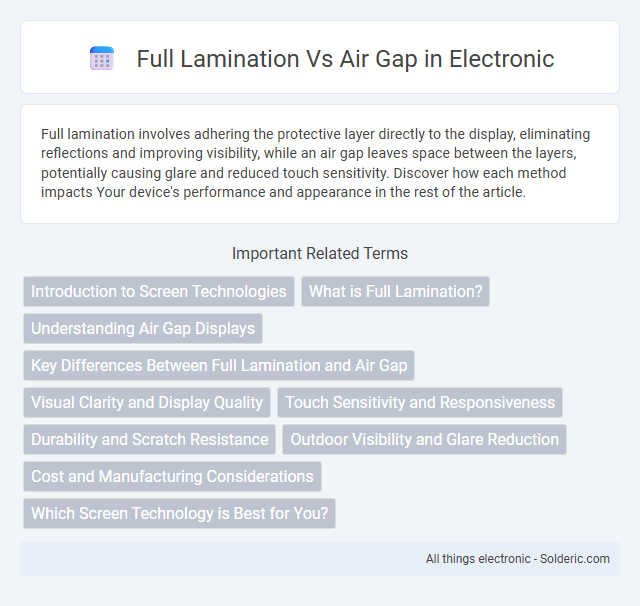Full lamination involves adhering the protective layer directly to the display, eliminating reflections and improving visibility, while an air gap leaves space between the layers, potentially causing glare and reduced touch sensitivity. Discover how each method impacts Your device's performance and appearance in the rest of the article.
Comparison Table
| Feature | Full Lamination | Air Gap |
|---|---|---|
| Definition | OCA (Optically Clear Adhesive) fully bonds the display to the touch panel or glass. | There is a physical air gap between the display and the touch panel or glass. |
| Image Quality | Improved brightness and contrast; reduces reflection and glare. | Reflections cause glare; lower optical clarity. |
| Touch Sensitivity | Better touch response due to closer panel integration. | Reduced touch sensitivity; less precise touch detection. |
| Durability | Enhanced structural strength; less prone to dust and moisture ingress. | Lower durability; risk of dust and moisture entering air gap. |
| Cost | Higher manufacturing cost due to lamination process. | Lower production cost; simpler assembly. |
| Repairability | Harder to repair or replace components due to bonded layers. | Easier to disassemble and repair. |
| Use Cases | Premium smartphones, tablets, and high-end displays. | Budget devices, industrial displays where cost is critical. |
Introduction to Screen Technologies
Full lamination enhances screen clarity and touch sensitivity by bonding the display panel directly to the protective glass, eliminating air gaps that cause reflections and light diffusion. Air gap screens maintain a layer of air between the display and glass, resulting in increased glare and reduced contrast in bright environments. Choosing full lamination for your device improves visibility and durability, making it ideal for smartphones, tablets, and other high-performance touchscreens.
What is Full Lamination?
Full lamination involves bonding the display panel directly to the protective glass or touchscreen layer, eliminating the air gap between them. This technique reduces reflections, enhances brightness and contrast, and improves touch responsiveness by minimizing parallax effects. Your device benefits from clearer visuals and a more seamless user experience compared to air gap screens.
Understanding Air Gap Displays
Air gap displays feature an unfilled space between the display panel and touch sensor, which can cause increased reflection and reduced image clarity compared to full lamination. Full lamination eliminates the air gap by bonding the layers directly, enhancing touch sensitivity, brighter colors, and improved viewing angles. Understanding the air gap effect is crucial for industries like smartphones and tablets where display quality directly impacts user experience.
Key Differences Between Full Lamination and Air Gap
Full lamination involves bonding the touch panel directly to the LCD using optical-grade adhesive, which eliminates air gaps and enhances display clarity, brightness, and durability. Air gap technology leaves a small layer of air between the touch panel and the display, which can cause reflections and reduce contrast but may be more cost-effective and easier to repair. Your choice between full lamination and air gap impacts viewing experience, device thickness, and overall device resilience.
Visual Clarity and Display Quality
Full lamination eliminates the air gap between the display panel and touch glass, significantly reducing internal reflections and enhancing visual clarity with higher contrast and more vibrant colors. Air gap displays suffer from light scattering and refraction within the gap, causing glare, reduced brightness, and washed-out images. Consequently, full lamination delivers superior display quality by minimizing parallax effects and improving touch sensitivity.
Touch Sensitivity and Responsiveness
Full lamination enhances touch sensitivity and responsiveness by minimizing the distance between the display glass and the LCD panel, resulting in reduced parallax and faster touch recognition. Air gap displays have a noticeable space between the layers, which can slightly delay touch input and reduce accuracy, especially under direct sunlight or heavy use. Devices with full lamination provide a more precise and seamless interaction, making them ideal for applications requiring high touch performance.
Durability and Scratch Resistance
Full lamination offers superior durability and scratch resistance by bonding the display firmly to the touchscreen, reducing internal reflections and protecting against external damage. Air gap displays, while more affordable, are prone to dust accumulation and can be more vulnerable to scratches due to the separated layers. Your choice of full lamination ensures enhanced device longevity and a clearer, more resilient screen surface.
Outdoor Visibility and Glare Reduction
Full lamination significantly enhances outdoor visibility by eliminating the air gap between the display and the cover glass, reducing reflections and glare from sunlight. This technology improves screen readability under bright conditions, making your device easier to view in direct sunlight. Air gap displays, in contrast, often produce more glare and reflections, diminishing clarity during outdoor use.
Cost and Manufacturing Considerations
Full lamination involves bonding the display panel directly to the cover glass with optical adhesive, reducing reflections and improving durability but increasing manufacturing complexity and material costs. Air gap technology separates the display and cover glass with an air layer, resulting in lower production expenses and simpler assembly processes, though it may lead to decreased display clarity and increased reflection. When choosing between the two, your decision should weigh the higher upfront investment of full lamination against the budget-friendly, yet less optically optimized, air gap alternative.
Which Screen Technology is Best for You?
Full lamination eliminates the air gap between the touch panel and the display, resulting in reduced glare, enhanced contrast, and improved touch sensitivity compared to traditional air gap screens. Air gap technology can create reflections and reduce image clarity, making full lamination the superior choice for outdoor use or high-precision applications. Your decision should consider factors like device usage, environmental conditions, and budget, with full lamination offering better durability and visual performance.
Full lamination vs Air gap Infographic

 solderic.com
solderic.com